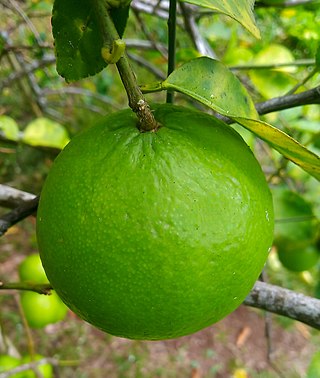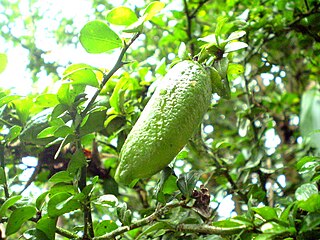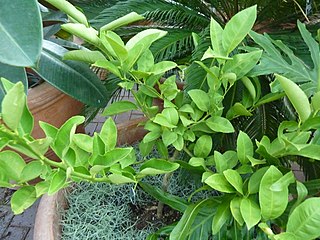
Citrus is a genus of flowering trees and shrubs in the rue family, Rutaceae. Plants in the genus produce citrus fruits, including important crops such as oranges, lemons, grapefruits, pomelos, and limes. The genus Citrus is native to South Asia, East Asia, Southeast Asia, Melanesia, and Australia. Various citrus species have been used and domesticated by indigenous cultures in these areas since ancient times. From there its cultivation spread into Micronesia and Polynesia by the Austronesian expansion ; and to the Middle East and the Mediterranean via the incense trade route, and onwards to Europe and the Americas.

Citrus hystrix, called the kaffir lime or makrut lime, is a citrus fruit native to tropical Southeast Asia.

A lime is a citrus fruit, which is typically round, green in color, 3–6 centimetres (1.2–2.4 in) in diameter, and contains acidic juice vesicles.

Australian limes are species of the plant genus Citrus that are native to Australia and Papua New Guinea.

Blood limes are a hybrid citrus fruit developed by the CSIRO project to investigate salt-resistant crops.

Persian lime, also known by other common names such as seedless lime, Bearss lime and Tahiti lime, is a citrus fruit species of hybrid origin, known only in cultivation. The Persian lime is a triploid cross between Key lime and lemon.

The Key lime or acid lime is a citrus hybrid native to tropical Southeast Asia. It has a spherical fruit, 25–50 mm (1–2 in) in diameter. The Key lime is usually picked while it is still green, but it becomes yellow when ripe.

Citrus australasica, the Australian finger lime or caviar lime, is a thorny understorey shrub or small tree of lowland subtropical rainforest and rainforest in the coastal border region of Queensland and New South Wales, Australia.

Citrus glauca, commonly known as the desert lime, is a thorny shrub or small tree native to Queensland, New South Wales, and South Australia. The 1889 book The Useful Native Plants of Australia records common names native kumquat and desert lemon.

Citrus australis, the Dooja, round lime, Australian lime or Australian round lime, is a large shrub or small tree producing an edible fruit. It grows in forest margins in the Beenleigh area and northwards, in Queensland, Australia.
The false oranges are a group of flowering plants in the Citrus genus, within the family, Rutaceae. They are endemic to New Caledonia.
C. gracilis may refer to:
Citrus latipes, commonly called "Khasi papeda", is sometimes mistakenly identified as Kaffir lime. Native to Northeast India, the khasi papeda is a small, thorny tree that closely resembles both kaffir limes and ichang papedas. Though rarely eaten, and extremely rare in cultivation, the fruit is edible.

Citrus garrawayi, the Mount White lime, is a tree native to the Cape York region of northern Queensland in Australia. It is an understory tree in tropical rainforests.

Citrus inodora or Microcitrus inodora, commonly known as Russell River lime or large leaf Australian wild lime, is a tree native to the Bellenden-Ker Range in northern Queensland, Australia.
Citrus wintersii, the Brown River finger lime, is a shrub native to the Brown River region in Papua-New Guinea. It was previously known as Microcitrus papuana. It has, as the "finger" name suggests, a small, thin fruit, pointed at both ends. It grows near Port Moresby.
Citrus warburgiana. the kakamadu or New Guinea wild lime, grows on the south coast of the Papuan Peninsula near Alotau in Papua-New Guinea.

Citrus taxonomy refers to the botanical classification of the species, varieties, cultivars, and graft hybrids within the genus Citrus and related genera, found in cultivation and in the wild.

Citrus limettioides, Palestinian sweet lime or Indian sweet lime or common sweet lime, alternatively considered a cultivar of Citrus × limon, C. × limon 'Indian Lime', is a low-acid lime used in Palestine for food, juice and rootstock. It is a member of the sweet limes. Like the Meyer lemon, it is the result of a cross between the citron and a mandarin/pomelo hybrid distinct from sweet and sour oranges.













